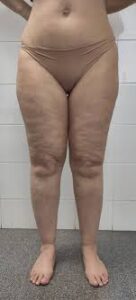Cellulite is a common condition that affects many people, especially women. It appears as dimpled, lumpy skin, often found on the thighs, buttocks, and hips. While weight loss can reduce the appearance of cellulite, it’s not always a complete solution. In this article, we’ll explore how weight loss impacts cellulite and what you can do to improve its appearance.
What is Cellulite?



Cellulite is the appearance of lumpy, dimpled skin caused by fat deposits pushing through the connective tissue beneath the skin. It is most commonly found on the thighs, buttocks, and hips, but it can also appear on the stomach and arms. Cellulite is not necessarily a sign of poor health, but rather a natural condition that affects many people.
The formation of cellulite occurs when fat cells in the body expand and push against the fibrous connective tissue underneath the skin. This pressure causes the skin to become dimpled and uneven, giving it a “cottage cheese” appearance.
Why Do People Get Cellulite?
(Photo Credit to Respective Owner reddit)
There are several factors that contribute to the development of cellulite. Some of the most common factors include:
- Hormones
Hormones play a significant role in the formation of cellulite. Estrogen, a hormone primarily found in women, is thought to contribute to the development of cellulite by affecting the blood flow and fat storage in the body. As women age and their hormone levels change, particularly during menopause, the appearance of cellulite can become more noticeable.
- Genetics
Genetics can also influence the likelihood of developing cellulite. Some people are genetically predisposed to have more fat storage in areas like the thighs, hips, and buttocks, making them more likely to experience cellulite.
- Diet and Lifestyle
A poor diet high in processed foods, sugar, and unhealthy fats can lead to weight gain, which may worsen the appearance of cellulite. Additionally, a lack of exercise and sedentary behavior can lead to weakened muscles and poor circulation, which may contribute to cellulite formation.
- Age
As we age, our skin becomes less elastic, and the connective tissue in the skin weakens. This can make cellulite more visible as the skin starts to sag and lose its firmness.
Does Weight Loss Affect Cellulite?
Many people wonder if weight loss can help reduce the appearance of cellulite. The short answer is yes, but it’s not always a complete solution. Losing weight can reduce the fat stores in your body, which may decrease the appearance of cellulite in some cases.
However, it’s important to understand that cellulite is not just caused by fat. It is also influenced by factors like muscle tone, skin elasticity, and connective tissue structure. As a result, even after losing weight, cellulite may still be visible, especially in areas where the skin has lost elasticity or if you have a genetic predisposition to cellulite.
What Happens to Cellulite After Weight Loss?
(Photo Credit to Respective Owner reddit )
When you lose weight, the fat cells in your body shrink. This can lead to a reduction in the appearance of cellulite, as there is less fat pushing against the skin. However, the extent to which weight loss improves the appearance of cellulite varies from person to person.
In some cases, weight loss may significantly improve the appearance of cellulite, especially if the condition was primarily caused by excess fat. In other cases, the reduction in fat may not be enough to completely smooth out the skin, and cellulite may remain visible.
Can You Prevent Cellulite with Weight Loss?
While weight loss can help reduce the appearance of cellulite, it may not necessarily prevent it from forming. If cellulite is caused by factors like genetics or hormonal changes, losing weight may not prevent it from appearing.
However, maintaining a healthy weight through a balanced diet and regular exercise can help minimize the development of new cellulite. By keeping your muscles toned and your body fat percentage low, you can reduce the chances of cellulite becoming more pronounced.
How to Reduce the Appearance of Cellulite After Weight Loss?
There are several steps you can take to reduce the appearance of cellulite after weight loss. These include:
Exercise
Regular exercise, particularly strength training and cardiovascular workouts, can help tone the muscles beneath the skin. This can make the skin appear firmer and reduce the dimpled look of cellulite. Targeted exercises, such as squats, lunges, and leg lifts, can help tone the thighs and buttocks, the areas most affected by cellulite.
Improve Skin Elasticity
As we age, the skin loses its natural elasticity, which can make cellulite more noticeable. To improve skin elasticity, consider using topical treatments that contain ingredients like retinol, which can help boost collagen production. Collagen is the protein responsible for keeping the skin firm and elastic.
Stay Hydrated
Drinking plenty of water is important for overall skin health. Staying hydrated can help improve the appearance of cellulite by keeping your skin plump and hydrated. When the skin is well-hydrated, it is more likely to appear smooth and firm.
Eat a Healthy Diet
A healthy diet that is rich in vitamins, minerals, and antioxidants can help improve skin health and reduce the appearance of cellulite. Focus on eating plenty of fruits, vegetables, lean proteins, and healthy fats. Foods like salmon, avocado, and berries are particularly beneficial for skin health.
Can Cellulite Be Completely Removed?
While there are treatments and lifestyle changes that can help reduce the appearance of cellulite, it is important to understand that there is no permanent cure for cellulite. The condition is a natural part of the body, and most treatments only offer temporary improvements.
Some popular treatments for cellulite include:
- Massage therapy: Massaging the affected areas can improve circulation and reduce the appearance of cellulite by temporarily smoothing the skin.
- Laser therapy: Laser treatments can help break down fat cells and stimulate collagen production, which can improve skin texture.
- Topical creams: Creams that contain caffeine or retinol can temporarily reduce the appearance of cellulite by tightening the skin.
How Long Does It Take to See Results from Weight Loss and Cellulite Reduction?
The time it takes to see results from weight loss and cellulite reduction varies depending on individual factors like genetics, the amount of weight lost, and the methods used to target cellulite. In general, you may start to see improvements in the appearance of cellulite within a few weeks to a few months after beginning a weight loss program.
However, it’s important to remember that results will not be instant, and the process may take time. Consistency with your exercise routine, diet, and skincare regimen is key to achieving the best possible results.
Conclusion
Cellulite is a common condition that affects many people, but weight loss can help reduce its appearance. While losing weight can shrink fat cells and improve the overall look of your skin, it may not completely eliminate cellulite, especially if other factors like genetics and aging are involved. For the best results, combine weight loss with exercise, a healthy diet, and treatments that improve skin elasticity.
FAQs
Will losing weight completely get rid of cellulite?
Losing weight can reduce the appearance of cellulite by shrinking fat cells, but it may not eliminate it completely. Other factors like genetics, skin elasticity, and aging play a role in the appearance of cellulite.
Are there any treatments that can permanently remove cellulite?
There is no permanent cure for cellulite. Treatments like laser therapy, massage, and topical creams can temporarily reduce its appearance, but cellulite may return over time.
How long does it take to see improvement in cellulite after weight loss?
It may take a few weeks to several months to see improvements in cellulite after weight loss. The timeline depends on factors such as your weight loss progress, exercise routine, and skincare efforts. Consistency is key.

